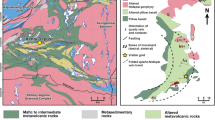Abstract
A sequence of oxidate facies sediments associated with a cupriferous massive sulphide deposit in the Solomon Islands is the product of precipitation at an exhalative fluid/seawater interface. A siliceous sinter bed within the sediments contains magnesioferrite spheroids having a distinctive framboid texture. Scanning electron micrographs of the spheroids show an internal structure of parallel rods composed of sub-spherical microcrysts. The formation of the magnesioferrite framboid texture is ascribed to the coagulation of magnetic iron hydroxide gel particles due to magnetic attraction but facilitated by the presence of a strong electrolyte. By analogy a simple mechanism to account for pyrite framboid formation is proposed. This mechanism requires primary iron sulphide particels to be attracted to one another because of the ferrimagnetic properties of a precursor FeS polymorph or alternatively by Van der Waals forces accentuated by the presence of charged ions in a strong electrolyte. Ordering of resultant microcrysts is mainly a close-packing effect which produces robust aggregates resistant to deformation during subsequent diagenesis.
Similar content being viewed by others
References
Annerstein H (1969) Magnetites from a Sulphide Bearing Iron Ore Formation in Sweden. Mineral Deposita 4: 234–240
Bennett CEG, Graham J (1980) New observations on natural pyrrhotites, Part III. Thermomagnetic experiments. Am Mineral 65: 800–807
Farrand M (1970) Framboidal Sulphides Precipitated Synthetically. Mineral Deposita 5: 237–247
Kribek B (1975) The Origin of Framboidal Pyrite as a Surface Effect of Sulphur Grains. Mineral Deposita 10: 389–396
Love LG (1967) Early diagenetic iron sulphide of the Wash (England). Sedimentology 9: 327–352
Love LG, Amstutz GC (1969) Framboidal Pyrite in two Andesites. NJ Miner Monat
Massad M (1974) Framboidal Pyrite in Concretions. Mineral Deposita 9: 87–89
Oehler JH (1976) Hydrothermal Crystallisation of Silica Gel. Geol Soc Am Bull 87: 1143–1152
Ostwald J, England BM (1977) Notes on Framboidal Pyrite from Allandale, New South Wales, Australia. Mineral Deposita 12: 111–116
Papunen H (1966) Framboidal texture of the pyrite layer found in a peat bog in SE Finland. C. R. Soc Geol Finland 38: 117–125
Rickard DT (1970) The Origin of Framboids. Lithos 3: 269–293
Roberts W MB, Walker AL, Buchanan AS (1969) The Chemistry of Pyrite Formation in Aqueous Solution and its Relation to the Depositional Environment. Mineral Deposita 4: 18–29
Rust GW (1935) Colloidal primary copper ores at Cornwall Mines, South-eastern Missouri. J Geol 43: 398–426
Schneiderhöhn H (1923) Chalkographische Untersuchung des Mansfelder Kupferschiefers. N Jb Miner Geol Palaont 47: 1–38
Sweeney RE, Kaplan IR (1973) Pyrite Framboid Formation. Laboratory Synthesis and Marine Sediments. Econ Geol 68: 618–634
Taylor GR (1974) Volcanogenic Mineralisation in the Islands of the Florida Group, B.S.I.P. Trans Instn Min Metall Sect B Appl Earth Sci 83: 120–130
Taylor GR (1981) The Geology and Ore Deposits of the West Florida Islands. Solomon Isl Geol Surv Bull 8: (in press)
Uytenbogaardt W, Burke EAJ (1971) Tables for Microscopic Identification of Ore Minerals. 2nd edit. Elsevier, Amsterdam, p 430
Walton A G (1967) The formation and properties of precipitates. New York, Interscience p 232
Author information
Authors and Affiliations
Rights and permissions
About this article
Cite this article
Taylor, G.R. A mechanism for framboid formation as illustrated by a volcanic exhalative sediment. Mineral. Deposita 17, 23–36 (1982). https://doi.org/10.1007/BF00206374
Received:
Issue Date:
DOI: https://doi.org/10.1007/BF00206374




